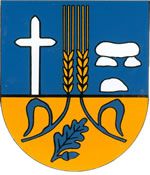Spahnharrenstätte: Difference between revisions
Jump to navigation
Jump to search
Knorrepoes (talk | contribs) m (Text replacement - "{{de}}" to "") |
Knorrepoes (talk | contribs) m (Text replacement - "{| class="wikitable"↵|+Official blazon↵|-↵|'''German'''↵| ↵|-↵|'''English''' ↵| {{blazon wanted}}↵|}" to "{| class="wikitable" |+Official blazon |- |'''German''' | blazon wanted |- |'''English''' | blazon wanted |}") |
||
| Line 14: | Line 14: | ||
|- | |- | ||
|'''German''' | |'''German''' | ||
| | | blazon wanted | ||
|- | |- | ||
|'''English''' | |'''English''' | ||
| | | blazon wanted | ||
|} | |} | ||
Revision as of 08:10, 6 April 2023
SPAHNHARRENSTÄTTE
State : Niedersachsen
District (Kreis) : Emsland (until 1977 Aschendorf-Hümmling)
Additions : 1966 Harrenstätte, Spahn
Samtgemeinde : Samtgemeinde Sögel
| German | blazon wanted |
| English | blazon wanted |
Origin/meaning
The two wheat-ears symbolise the agricultural character of the municipality. They also symbolise the two former municipalities that merged to the new municipality of Spahnharrenstätte. The oak leaf in the base is a symbol for the many oak trees in the villages, especially the village squares. The cross is a symbol to remember the plague epidemy, which stuck the villages in the 17th century. The Sone Age grave symbolises the many monolithic structures that can be found in the region. It also indicates the longtime inhabitation of the area.
